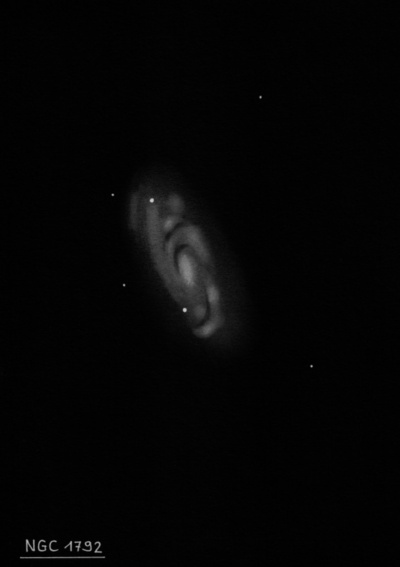
James Dunlop discovered NGC 1792 = D 531 = h2730 on 4 Oct 1826 and described "a long or rather elliptical nebula, about 2' long and 50" broad, a little brighter in the middle, and well defined. There is a group of small stars on the north side." JH lists 3 observations in the Cape Catalogue: on his first sweep on 24 Dec 1835 he logged "vB, vL, vmE, gbM, 4' long. Taken as Dunlop 531 but too late for transit, the observation having been missed by relying on Mr Dunlop's place." Then 2 nights later he revisited this galaxy and noted "vB, vL, mE, glbM, 5' long, 2' broad, pos 314?, stars seen in it. Visible with moonlight and lamp illumination". Finally on a third sweep he noted "B, vL, mE, regular elliptic; resolved. I see several small stars in it."
This starburst spiral has a mean distance of ~42 million light years and spans 70,000 l.y. across. We view it inclined ~28? from edge-on.
200/250mm - 8" (1/1/84): moderately bright, moderately large, slightly elongated.
8" (11/28/81): fairly faint, round, moderately large, diffuse.
300/350mm - 13.1" (2/20/04 - Costa Rica): at 105x appears as a bright, large oval ~2:1 NW-SE, 3.2'x1.6'. Broad concentration to a large bright core and then sharply concentrated with a bright, 15" nucleus. The surface brightness is irregular with a mottled texture. A faint star is just preceding the northwest tip. At 166x the galaxy appears brighter along the major axis with some areas of lower surface brightness giving a hint of spiral structure! A mag 14 star is at the preceding edge [1.2' from center]. Brightest in a group (LGG 127) along with NGC 1808 40' NE.
400/500mm - 17.5" (1/31/87): bright, large, elongated 2:1 NW-SE, 3'x1.5', pretty diffuse. Two faint mag 14.5 stars are superimposed. Appears brighter along the western side.
Notes by Steve Gottlieb